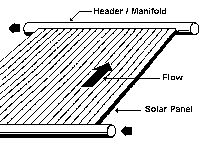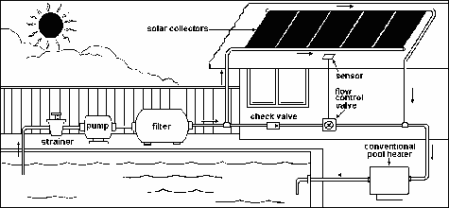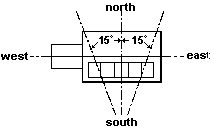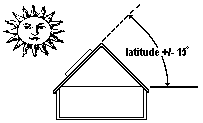Swimming pools are big energy consumers. Pool owner/operators spend billions of dollars annually to heat the world's pools. Much of this energy is often wasted and can be saved with proper management. Wasting energy also contributes to our growing air quality problem.
Why Solar
Most swimming pools require some type of heating, whether to bring the pool up to temperature in the spring, to maintain a desired temperature during the swimming season, or to extend the swimming season. You can use conventional gas or electric heaters, but you may have large monthly bills from your local utility company.
Another option is to install a heating system that captures the free heat of the sun. Solar energy is a renewable domestic fuel that's widely available. Today, solar pool heating systems can be cost competitive with conventional heaters. Their advantage...very low operating costs.
Solar pool heating uses lower cost collectors and low water temperatures making it a cost-effective use of solar energy.
Solar Collectors
 The simplest solar collector is a black hose lying in the sun that you can circulate water through. The sun shines on the black hose and heats up the water flowing through it. This is not a very efficient or durable solar collector, however.
The simplest solar collector is a black hose lying in the sun that you can circulate water through. The sun shines on the black hose and heats up the water flowing through it. This is not a very efficient or durable solar collector, however.
To increase the efficiency of collecting solar heat, solar collector manufacturers have designed several types of solar collectors that maximize the amount of solar energy collected and are designed to last 15-20 years.
Most solar collectors are flat sheets, called absorber plates, with tubes running from bottom to top. Headers at the top and bottom supply the fluid to be heated. Some have a glazing over the top of the collector that aids in preventing the wind and cold air from carrying away the heat before it can get to its destination, but this greatly increases the cost of the collector..
Solar collectors are made of a variety of materials. Collectors that operate only when temperatures are above freezing can be made of lower cost materials such as thermoplastic rubber or polypropylene. These collectors can be used in the far southern part of the U.S. and for all outdoor seasonal use pools in the rest of the U.S.
Collectors that operate in colder climates on a year around basis generally have copper absorber plates with low iron tempered glass as a covering. This allows the collector to maintain most of its efficiency even during the cold winter months. As long as the sun is shining, it will collect some solar heat. But these collector systems require transfer fluid and heat exchangers which increase the total system cost.
Solar Heating Systems
 Solar collectors are only one part of a total solar pool heating system. A simple unglazed pool heating system includes the pool pump and two heat sensors connected to a solar controller. One sensor measures the temperature at the collector surface. The other measures the pool temperature. If the difference between the two is sufficient, the controller sends a signal to a motorized valve that closes and directs the pool water through the solar collectors.
Solar collectors are only one part of a total solar pool heating system. A simple unglazed pool heating system includes the pool pump and two heat sensors connected to a solar controller. One sensor measures the temperature at the collector surface. The other measures the pool temperature. If the difference between the two is sufficient, the controller sends a signal to a motorized valve that closes and directs the pool water through the solar collectors.
All the water circulated by the filter pump will pass through the solar system. Each time the water passes through the solar collectors it is heated 2-5 degrees. A properly sized solar system can raise the pool temperature 10-20 degrees and maintain a comfortable swimming temperature.
The purpose of solar heating a pool is usually to provide a comfortable and enjoyable pool water temperature during mild weather. Under these conditions, systems with open absorber plate solar collectors are most efficient and cost effective. These unglazed systems can even work for indoor pools in cold climates if the system is designed to drain back to the pool when not in use. Even if you have to shut the system down during cold weather, it may be more cost effective than installing a more expensive glazed collector system.
Glazed collectors systems can also be used to heat pools. Due to the ability of the glazing to trap heat and by using copper absorber plates, heat exchangers and transfer fluids, these systems can collect large amounts of solar heat even in the coldest weather. However, glazed solar systems often cost several times as much as unglazed systems. Another advantage of glazed systems is that they can double to heat domestic hot water year around.
A modern pump, properly sized for filtration and skimmer action will almost always be adequate for a solar system. The extra lift to the roof is balanced by the return head in a closed system. If the pump isn't large enough, a booster pump will have to be added.
Siting
There are a number of things to consider when trying to determine if a solar pool heating system is right for your pool.
Is there a large, sunny roof or open area available for mounting several hundred square feet of solar collector? Does the area have unobstructed sunlight from 8:00 am to 4:00 pm during the heating season or even later in the day for mid-summer use? Is it possible to securely anchor the collectors on the selected area? (The solar collectors can be mounted on a roof, on a deck, on a rack, or on the ground).
Also, the system should be installed in accordance with all local building and zoning requirements.
Orientation and Tilt
 Ideally, collectors should face due south in the northern hemisphere and due north in the southern hemisphere. However, they can usually be oriented within 15 east or west of south with little loss in performance. Some sources even say up to a 45 variation is OK, but you will lose some performance.
Ideally, collectors should face due south in the northern hemisphere and due north in the southern hemisphere. However, they can usually be oriented within 15 east or west of south with little loss in performance. Some sources even say up to a 45 variation is OK, but you will lose some performance.
 The ideal collector angle varies based on latitude, and whether you need the heat in the summer months, during the winter months, or you need the heat all year around.
The ideal collector angle varies based on latitude, and whether you need the heat in the summer months, during the winter months, or you need the heat all year around.
For summer only heating, use latitude minus 10-15. For winter only heating, use latitude plus 10-15. For year around heating, install the collectors at latitude. Variations from these ideals can be compensated for by adding additional collector area.
Sizing
Solar pool heating systems can be installed to provide up to 100% of your pool heating needs. The size of the system depends on available solar insolation, wind factors, average temperatures for the region, and collector orientation and angle. Contact your local supplier for a proper sizing calculation.
Pool Covers
It is a good idea to make your pool as efficient as possible before considering a solar pool heating system. The easiest way to lower your pool heating costs is to use a pool cover that stops evaporation when the pool is not in use.
By reducing your pool heating needs prior to the purchase of a solar pool heating system, you can purchase a smaller system, saving money.
If inconvenience or aesthetics is a major concern that keeps you from using a pool cover, then a solar pool heating system can provide you with low cost heat without affecting the looks of the pool.
Conclusions
Using solar energy to heat swimming pools is one of the best use of solar collection devices. Solar systems have become so easy to install that many pool owners can do it themselves. But, if you want a professionally installed system, contact a local solar dealer that has experience in solar heating swimming pools.